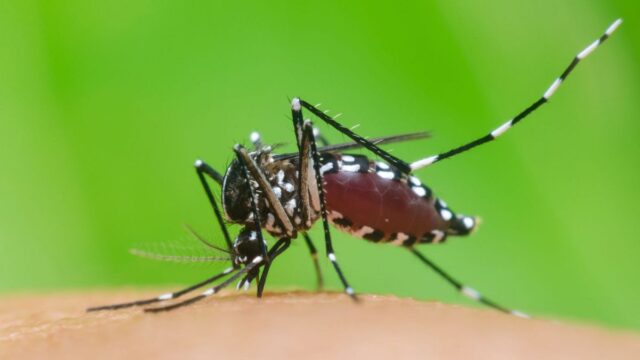Dengue cases almost doubled in the EU last year, as climate change creates more favorable conditions for the vectors.
Climate change is causing an increase in outbreaks of mosquito-borne diseases in Europe, according to the latest official figures.
He European Center for Disease Prevention and Control (ECDC) revealed this week that last year there were 130 cases of dengue in the EUcompared to 71 in 2022.
Recently there has been a rebound in cases in Europe and the United Stateswith the presence of the invasive mosquito species in thirteen EU countries.
The tiger mosquito transmits dengue
Dengue – also called broken bone fever because of how intense the joint pain can be – it is a viral infection life-threatening It is transmitted to humans through mosquito bites.
In the decade from 2010 to 2021, only 71 cases in total were reported across the EU.
“Europe is already seeing how the climate change is creating conditions favorable conditions for invasive mosquitoes to spread to previously unaffected areas and infect more people with diseases such as dengue,” he says. Andrea Ammondirector of the ECDC.
Hetiger mosquito(Aedes albopictus) carries the dengue, chikungunya and Zika viruses. This invasive species is spreading to the north, east and west of Europe, the continent that is warming the fastestand now has self-sustaining populations in 13 countries.
Where does the tiger mosquito spread in Europe?
Named for its black and white striped body, this mosquito was previously only found in tropical zones. It is now embedded in: Germany, Austria, Bulgaria, Croatia, Slovenia, Spain, France, Greece, Hungary, Italy, Malta, Portugal and Romania.
It has also been detected several times in ports from the United Kingdom in recent years, but does not seem to have settled on the island yet.
“The increase in international travel from countries where dengue is endemic will also increase the risk of imported cases, and inevitably also the risk of local outbreaks,” says Ammon.
This is also confirmed by the latest data from the ECDC. In 2023, more than 4,900 Europeans contracted dengue while traveling abroad, the highest number of imported cases since surveillance began in 2008, up from 1,572 cases in 2022.
Climate change and El Niño stimulate the spread of dengue
Last year it was also recorded the largest number of cases of dengue around the worldwith more than 6.5 million cases reported in more than 80 countries, resulting in 7,300 deaths related to this disease.
According to the World Health Organization (WHO), the epidemic is due to several factors. Firstly, the greater distribution of the tiger mosquito, which carries dengue, and the yellow fever mosquito (Aedes aegypti) in countries previously free of the plague.
The El Niño climate phenomenon, combined with climate change, made 2023 the hottest year ever recorded, and led to an increase in precipitation and humidity, favorable conditions for mosquitoes. The forecasts for this summerthey are even worse.
The WHO also points out that the disease hit hardest in countries that faced political and financial instabilities, with large movements of population in poor conditions and weakened health systems due to the COVID pandemic or lack of government funding.
What other diseases are mosquitoes bringing to Europe?
The tiger mosquito is not the only problematic species being driven by the winds of climate change.
The yellow fever mosquito – also a vector of the dengue, chikungunya and Zika viruses – arrived in Cyprus in 2022.
“Their potential to establish in other parts of Europe is worrying due to their significant capacity to transmit pathogens and their preference for biting humans,” warns the ECDC.
In March of this year, a case of local West Nile virus infection was reported in the Spanish city of Seville. “Although this is an isolated case, it shows that West Nile virus transmission can occur at the beginning of the year, probably due to suitable weather conditions,” the center adds. There were already more “isolated cases” before..
In the Italian region of Apulia , scientists identified the malaria-spreading mosquito Anopheles sacharovi earlier this year, 50 years after the country was declared free of the disease. The cause is believed to be increase in temperatures and the repopulation of their former habitats.








